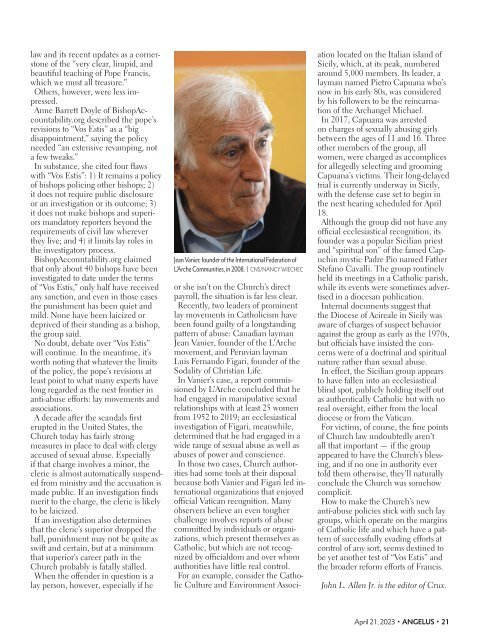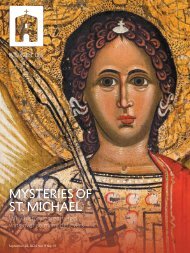Angelus News | April 21, 2023 | Vol. 8 No
On the cover: Christ pulls Adam out of “limbo” while surrounded by other biblical figures in a late 13th-century painting (artist unknown). St. John Chrysostom famously wrote about Easter: “Forgiveness is risen from the grave.” But what does that mean for us? On Page 10, Mike Aquilina details how history, Scripture, and the experience of the apostles reveals forgiveness as the Resurrection’s most tangible result. On Page 14, Jennifer Hubbard recounts how her 6-year-old daughter’s murder in the Sandy Hook shooting led her on a journey to do the impossible.
On the cover: Christ pulls Adam out of “limbo” while surrounded by other biblical figures in a late 13th-century painting (artist unknown). St. John Chrysostom famously wrote about Easter: “Forgiveness is risen from the grave.” But what does that mean for us? On Page 10, Mike Aquilina details how history, Scripture, and the experience of the apostles reveals forgiveness as the Resurrection’s most tangible result. On Page 14, Jennifer Hubbard recounts how her 6-year-old daughter’s murder in the Sandy Hook shooting led her on a journey to do the impossible.
You also want an ePaper? Increase the reach of your titles
YUMPU automatically turns print PDFs into web optimized ePapers that Google loves.
law and its recent updates as a cornerstone<br />
of the “very clear, limpid, and<br />
beautiful teaching of Pope Francis,<br />
which we must all treasure.”<br />
Others, however, were less impressed.<br />
Anne Barrett Doyle of BishopAccountability.org<br />
described the pope’s<br />
revisions to “Vos Estis” as a “big<br />
disappointment,” saying the policy<br />
needed “an extensive revamping, not<br />
a few tweaks.”<br />
In substance, she cited four flaws<br />
with “Vos Estis”: 1) It remains a policy<br />
of bishops policing other bishops; 2)<br />
it does not require public disclosure<br />
or an investigation or its outcome; 3)<br />
it does not make bishops and superiors<br />
mandatory reporters beyond the<br />
requirements of civil law wherever<br />
they live; and 4) it limits lay roles in<br />
the investigatory process.<br />
BishopAccountability.org claimed<br />
that only about 40 bishops have been<br />
investigated to date under the terms<br />
of “Vos Estis,” only half have received<br />
any sanction, and even in those cases<br />
the punishment has been quiet and<br />
mild. <strong>No</strong>ne have been laicized or<br />
deprived of their standing as a bishop,<br />
the group said.<br />
<strong>No</strong> doubt, debate over “Vos Estis”<br />
will continue. In the meantime, it’s<br />
worth noting that whatever the limits<br />
of the policy, the pope’s revisions at<br />
least point to what many experts have<br />
long regarded as the next frontier in<br />
anti-abuse efforts: lay movements and<br />
associations.<br />
A decade after the scandals first<br />
erupted in the United States, the<br />
Church today has fairly strong<br />
measures in place to deal with clergy<br />
accused of sexual abuse. Especially<br />
if that charge involves a minor, the<br />
cleric is almost automatically suspended<br />
from ministry and the accusation is<br />
made public. If an investigation finds<br />
merit to the charge, the cleric is likely<br />
to be laicized.<br />
If an investigation also determines<br />
that the cleric’s superior dropped the<br />
ball, punishment may not be quite as<br />
swift and certain, but at a minimum<br />
that superior’s career path in the<br />
Church probably is fatally stalled.<br />
When the offender in question is a<br />
lay person, however, especially if he<br />
Jean Vanier, founder of the International Federation of<br />
L’Arche Communities, in 2008. | CNS/NANCY WIECHEC<br />
or she isn’t on the Church’s direct<br />
payroll, the situation is far less clear.<br />
Recently, two leaders of prominent<br />
lay movements in Catholicism have<br />
been found guilty of a longstanding<br />
pattern of abuse: Canadian layman<br />
Jean Vanier, founder of the L’Arche<br />
movement, and Peruvian layman<br />
Luis Fernando Figari, founder of the<br />
Sodality of Christian Life.<br />
In Vanier’s case, a report commissioned<br />
by L’Arche concluded that he<br />
had engaged in manipulative sexual<br />
relationships with at least 25 women<br />
from 1952 to 2019; an ecclesiastical<br />
investigation of Figari, meanwhile,<br />
determined that he had engaged in a<br />
wide range of sexual abuse as well as<br />
abuses of power and conscience.<br />
In those two cases, Church authorities<br />
had some tools at their disposal<br />
because both Vanier and Figari led international<br />
organizations that enjoyed<br />
official Vatican recognition. Many<br />
observers believe an even tougher<br />
challenge involves reports of abuse<br />
committed by individuals or organizations,<br />
which present themselves as<br />
Catholic, but which are not recognized<br />
by officialdom and over whom<br />
authorities have little real control.<br />
For an example, consider the Catholic<br />
Culture and Environment Association<br />
located on the Italian island of<br />
Sicily, which, at its peak, numbered<br />
around 5,000 members. Its leader, a<br />
layman named Pietro Capuana who’s<br />
now in his early 80s, was considered<br />
by his followers to be the reincarnation<br />
of the Archangel Michael.<br />
In 2017, Capuana was arrested<br />
on charges of sexually abusing girls<br />
between the ages of 11 and 16. Three<br />
other members of the group, all<br />
women, were charged as accomplices<br />
for allegedly selecting and grooming<br />
Capuana’s victims. Their long-delayed<br />
trial is currently underway in Sicily,<br />
with the defense case set to begin in<br />
the next hearing scheduled for <strong>April</strong><br />
18.<br />
Although the group did not have any<br />
official ecclesiastical recognition, its<br />
founder was a popular Sicilian priest<br />
and “spiritual son” of the famed Capuchin<br />
mystic Padre Pio named Father<br />
Stefano Cavalli. The group routinely<br />
held its meetings in a Catholic parish,<br />
while its events were sometimes advertised<br />
in a diocesan publication.<br />
Internal documents suggest that<br />
the Diocese of Acireale in Sicily was<br />
aware of charges of suspect behavior<br />
against the group as early as the 1970s,<br />
but officials have insisted the concerns<br />
were of a doctrinal and spiritual<br />
nature rather than sexual abuse.<br />
In effect, the Sicilian group appears<br />
to have fallen into an ecclesiastical<br />
blind spot, publicly holding itself out<br />
as authentically Catholic but with no<br />
real oversight, either from the local<br />
diocese or from the Vatican.<br />
For victims, of course, the fine points<br />
of Church law undoubtedly aren’t<br />
all that important — if the group<br />
appeared to have the Church’s blessing,<br />
and if no one in authority ever<br />
told them otherwise, they’ll naturally<br />
conclude the Church was somehow<br />
complicit.<br />
How to make the Church’s new<br />
anti-abuse policies stick with such lay<br />
groups, which operate on the margins<br />
of Catholic life and which have a pattern<br />
of successfully evading efforts at<br />
control of any sort, seems destined to<br />
be yet another test of “Vos Estis” and<br />
the broader reform efforts of Francis.<br />
John L. Allen Jr. is the editor of Crux.<br />
<strong>April</strong> <strong>21</strong>, <strong>2023</strong> • ANGELUS • <strong>21</strong>


















